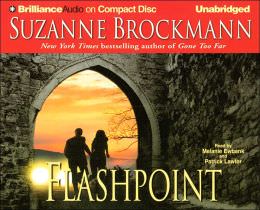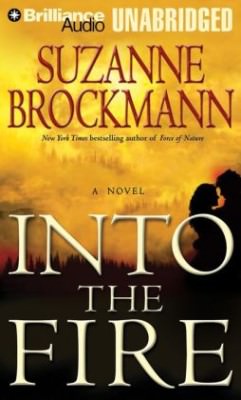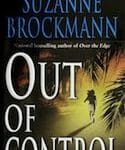 A Riff on Dual Narration and Suzanne Brockmann’s Troubleshooters and Some Other Stuff
A Riff on Dual Narration and Suzanne Brockmann’s Troubleshooters and Some Other Stuff
Suzanne Brockmann has two military suspense series of which I am a big, big fan – the original Tall, Dark and Dangerous series (TDD) where she introduces SEALs to her already prodigious body of work, and the Troubleshooter series (TSS) where a new group of SEALs goes on to create a private special ops/security business called Troubleshooters. Tall, Dark, etc., is part of her original Harlequin-style romance novel career, with suspense and SEALs; Troubleshooters is where she really takes off, using multiple relationships and story arcs that range over several full-length novels. She also incorporates a writing concept*that lends itself to looking at narration in a new way:
I use something that I call “deep point of view” in my books. This means that I get deep inside of the characters’ heads and tell the story through their eyes, using their voices — their words and thoughts — as well as their interpretations of various events. I stay in one single character’s POV for each scene in this book (and in other books in the Troubleshooters series, too).”
Dual narration works very well with deep POV – an entire scene told through the eyes of one character, using his/her voice, is read by the gender appropriate narrator. Keep in mind that this means all the narrative, and even the dialogue, is being filtered through this character’s brain. And one narrator reads all the dialogue until the POV switches along with the narrator.
I was introduced to TSS through Book 6, Gone Too Far, which was a major hit because it featured TSS’s favorite bad boy hero, Sam Starrett. Of course, I immediately glommed the series and read them in order. Starting with Into the Fire, number 13, I started listening to them instead of reading them. This was my introduction both to the dual narration and to Patrick Lawlor, who is now the male voice of Brockmann’s books in my mind. Into the Fire was the first time Lawlor was paired with Renée Raudman, who is one of my favorite narrators – previously the female narrator was Melanie Ewbank.
Lawlor is almost an unlikely male narrator for romance. His own voice is more tenor than basso profundo, and his delivery is pure suspense. His characters are differentiated in a number of ways – pitch, timbre, some accents – but they are all totally Lawlor. While I consider Nick Boulton’s delivery of the three Kinsales I’ve listened to pure acting, I would call Lawlor more of a storyteller. Maybe there’s a fine line betwixt the two approaches, and I don’t prefer one over the other, but it’s as if Lawlor himself came over to me in a coffee shop and sat down to tell me about one of the Troubleshooters characters. I can practically hear him saying, “Get this! Then Sam says,” etc etc. With Boulton, it’s more of a theatrical experience – I’m in the darkened audience, watching him on stage; we don’t connect.
 Both Raudman and Ewbank are great counterpoints for Lawlor – they both have medium-age, contemporary American narrative voices, and they do great character voices with some subtle accents, but are more likely to use timbre/pitch/tone to differentiate characters. They are also both good at creating suspense – a sort of urgency in the narration that heightens tension, a constant in this series.
Both Raudman and Ewbank are great counterpoints for Lawlor – they both have medium-age, contemporary American narrative voices, and they do great character voices with some subtle accents, but are more likely to use timbre/pitch/tone to differentiate characters. They are also both good at creating suspense – a sort of urgency in the narration that heightens tension, a constant in this series.
Unfortunately, the first 6 books in TSS were not recorded with Lawlor, Ewbank or Raudman. Each of the first 4 books has a different, single narrator, sometimes ok, sometimes DNF-worthy. Book 1, The Unsung Hero, is narrated by William Dufris, who pronounces the main character’s surname (Paoletti) completely wrong the entire book, among other travesties that had my eyes rolling. Book 2, The Defiant Hero, was a 5-star listen with narrator Carrington MacDuffie, but I didn’t even bother to start Book 3, Over the Edge, as the sample with narrator Laura Hicks stopped me cold at about the 3-second mark. When her tinny voice said “O’Leary and Lopez locked car-MODE-ee in the bathroom” (referring to Ken “Wild Card” Karmody, a name correctly pronounced CAR-muh-dee) and then goes on to pronounce Sam’s surname as STAH-ret instead of having it rhyme with carrot, I clicked the OFF button and moved on to surfing IRS regulations instead. I skipped Book 4, Out of Control, as well – on Audible, several reviews mentioned the narration as being monotonous, and worse. Book 5, Into the Night, and 6, Gone Too Far, are both cooling their heels in my iTunes list, waiting for a free moment to face an experience that can’t compare to Patrick Lawlor, Melanie Ewbank and Renée Raudman. When you have a craving for good dining, drive-through French fries aren’t that tempting. I just can’t bear to ruin a great book with a less-than-stellar audio performance.
The dual narrator approach works incredibly well with Brockmann’s books. Another way dual/multi narration works well is in first-person POV books with multiple characters – Audrey Niffenegger’s The Time Traveler’s Wife and Kathryn Stockett’s The Help are both excellent examples. But I don’t necessarily want publishers to start using multiple narrators on every book. For one thing, authors sometimes write short sections in POV, and switch more often than Brockmann; for another, when the narrator is good, regardless of gender, I prefer to hear the entire book done consistently. One of the criticisms of more than one narrator (reading in third person) is that they have different voices for the same character, which some find confusing.
I am not one who needs a male voice to read romance to me to make it believable. For one thing, I cut my audio teeth on the incredible likes of Davina Porter reading Diana Gabaldon’s Outlander series and Anna Fields/Kate Fleming reading Susan Elizabeth Phillips. I’ll take their hero voices over the travesty of (not going to name names) male narrators reading the females in high drag ANY DAY. Any. Day. Some may find A Certain Male Narrator the dreamiest voice ever but when he reads women with falsetto, I get cranky. I do like several male narrators who do not resort to their faux Julia Child voices for female characters, the most recent swoon-worthy one being Nick Boulton reading Laura Kinsale. [pause for fanning] And I know it’s possible for men to read women without invoking their inner Minnie Mouse – yet I can still enjoy a woman reading the entire book. However, I love the dual narration of Patrick Lawlor and Renée Raudman/Melanie Ewbank in Troubleshooters!
Now – let’s get the publisher to re-cast and re-record those first 6 books so we have a perfect set of Troubleshooters done right!
UPDATE FEBRUARY 2014: great news, the first four books are being re-recorded with the Lawlor/Ewbank team this year!
*I had a link to Brockmann’s web page where she talks about her deep POV concept but she re-did her website and that link is 404. Also, I searched her website for a reference and came up empty, so I’m glad I went ahead and copy/pasted from her website for my quote above!!!
Melinda




Truly awesome breakdown and analysis, Melinda!
You wrote: “…it’s as if Lawlor himself came over to me in a coffee shop and sat down to tell me about one of the Troubleshooters characters. I can practically hear him saying, “Get this! Then Sam says,” etc etc.”
And that’s EXACTLY my take on it, too. Said so brilliantly and concisely!
It’s also my analysis of my writing style, too. I intentionally set out to try to make the experience feel as if the reader was sitting across from me (in the guise of my characters), and I was telling her/him a story.
I have a terrible pet peeve about men making their voices higher when they read women’s dialogue. (Julia Child! That’s a terrific description of it!) Many of the women in my books (Alyssa!) can kick their audiobook narrator asses — and this is something Patrick and I have talked about at LENGTH. (While knowing that he’s under pressure from the audiobook publisher differentiate the female character’s dialogue in just that way.)
But, if a scene is in deep POV — for example, in FLASHPOINT, mentioned above, the first book Patrick and Melanie read, if the scene is in former SEAL chief Lawrence Decker’s POV, then Deck’s telling the story. Would Deck imitate someone’s voice if he were reporting what they said? No. Right? He’s not that guy. (Izzy, however, is.) I think Patrick does a really terrific job of balancing between character (Deck wouldn’t imitate, Izzy would, Jenk would a little, etc etc.) while still satisfying the audiobook publisher and the readers who don’t think about things like Deep POV and want a more traditional narration.
And is it just me, or do others find it a total turnoff when a female reader lowers her voice for the hero’s dialog? And add a southern accent, and he’s the Anti-Sexy. Yeeks. (Picture me lunging for the mute.)
I work so hard in my books to bust gender stereotype myths, I get all wince-y when the story is presented with little girl voices for the heroines and manly man moron heroes.
Ooh, one more totally off subject thing I wanted to add before I go and do my writing for the day, like a good author: I’m a performer. I’ve fronted my own rock band and I’ve led an a cappella group, and I’ve been on stage a lot. I’ve also produced many projects — including a CD for Serious Fun, my former a cappella group. So I’m familiar with recording studios, too.
With that in mind, as an extra bonus promotion for INTO THE STORM, I wrote a short story that was going to be in the back of the book. And I approached Brilliance about including it in the audio as a featured “extra.” They liked the idea, and they also okayed my request to go into the studio to record it myself.
The plan was for me to record at a studio I’d used before in Massachusetts, and send the tracks to Michigan to be mastered and included with the book, which Patrick and… I wanna say Renee?… were recording.
So I went into the studio — and mind you, this was a short story. Maybe 25 pages. Piece of cake, right? I’d done my prep work, read it through a coupla times, marked the stumble words and places.
But there I am, in the booth, in front of a mic, headphones on — I’ve been here before, no big. BUT. The band (or nine other singers) isn’t backing me up. There’s no kick drum and bass guitar rhythm section. Just. My. Voice. But no, NOT just my voice. There’s the sound of the pages when I turn them. The sound of my sleeve brushing against my side. The sound that I make when I shift my weight. The sound that my flappy mouth makes when I move it. Lip smacks. Who the hell knew that I sound so much like Jabba the freaking Hutt when I talk?!?
And suddenly, I need to clear my throat. Constantly. And I’m thirsty. Very, very thirsty.
Now, I’d talked to Patrick beforehand, asking for his sage advice, and he said something like, “Make sure you have lots and lots of water in there with you.” But he didn’t mention that the lots and lots of water would make me need lots and lots of trips to the bathroom.
Somehow, I got through it. 25 pages. SLURP, SMACK! It took a long time. Having experience as a producer, I’d reserved a long time, but in my fantasy, I’d walk in, read the thing in one twenty minute block, and walk out, triumphant — a one-take wonder.
Hah.
I stumbled out of the session like a prisoner making an escape, and immediately sent an email to Patrick. Because I had read 25 pages, and the books that he recorded were 500 – 600 manuscript pages. That translates to days and days — sometimes a full week — in the studio.
I’d always appreciated Patrick’s incredible talent, but after that experience, I also appreciated his athleticism. That was HARD work. Physically hard.
Okay. I’m done. Thanks again for this really insightful analysis. I’ll see what I can do about those first six TS books!
— Suz
Okay, not to laugh at your recording experience, but I did find it very entertaining!
I know as the one who records the Gals’ side of these interviews, I have lamented over hearing my side of things. Banged my head on the table upon hearing the first few interviews. And I’m a public speaker! I do this sort of thing and more – live! My verrryyyy slow southern/midwestern drawl about did me in. Especially considering the fact that I was talking with professional narrators (many in their sound booth)!
Your comment on (and response to):
“You wrote: “…it’s as if Lawlor himself came over to me in a coffee shop and sat down to tell me about one of the Troubleshooters characters. I can practically hear him saying, “Get this! Then Sam says,” etc etc.”
And that’s EXACTLY my take on it, too. Said so brilliantly and concisely!”
I must say when I read this piece from Melinda a few weeks back, that comment really stood out to me. She made me see Patrick in a whole new way. Oh, I enjoyed his narrations before but it added a level of appreciation to his performance as I listened to Headed for Trouble in preparation for this week. And to know it’s an apt analysis of your writing style as well!
As one who listens to audiobooks a LOT (no surprise there), I do need clear differentiation of the male and female characters when there is only one narrator. I’m a multi-tasker listener and want to be able to tell which character is speaking without listening all that closely. So, I appreciate a female narrator who can effectively lower her voice to accommodate male characters – if it sounds realistic. Not all that many can pull it off really well and those that do usually have a natural lower range to their voice. Stars for this type of male differentiation are Davina Porter, Anna Fields, Xe Sands, Natalie Ross, Renee Raudman, Tavia Gilbert, Barbara Rosenblat, and Karen White (who has improved this aspect of her narration a great deal). I’m sure I’m leaving a number I admire out.
But I imagine you may agree with me on another aspect of female narration. Please female narrators, don’t take your voice squeaky high to differentiate your female characters from your males. To me, it’s the same as a male doing the Julia Child thing. If I listen to a female narration and the heroine sounds unrealistic (as in her character is performed in too high of a range), I have a hard time ignoring it. I start thinking about that unrealistic high voice coming from a female for a female rather than the storyline. When that happens, it’s best to just pick up the book and read. For successful narration, I have to believe that each character would actually sound like that in real life without me doing a double take each time I heard them speak. I know, that must be terribly hard at times which makes me appreciate successful differentiation of characters all the more. Thank you narrators!!
I agree with you about 99.999% but…
“And is it just me, or do others find it a total turnoff when a female reader lowers her voice for the hero’s dialog?”
No, it’s not a turn off for me when it’s done right! You obviously need to hear Kate Fleming/Anna Fields narrate, uh, anything! She did Susan Elizabeth Phillips’ Chicago Stars – one of my all-time-fave series of lighter contemporary romance – and she did a bangup sexy job of Karen Robards’ One Summer. She had the chops for lowering the voice in a natural way. Listen to One Summer and tell me you didn’t fall half in love with her hero!!
In fact, if a female narrator doesn’t differentiate between her hero and heroine by pitch, I’m not happy – she needs to make the effort, even if it is raising her natural pitch for the heroine and lowering it for the hero. Not to the extent she starts developing nodes on her vocal chords, but…
Other than that – YOU DA MAN! I mean, uh, woman. Now, where can we get this reading-by-author?? AND STAY TUNED cuz I’m riffing on Headed for Trouble this week, where I lay some more fangrrl gushing on Patrick and Melanie and Suz… And I think Brenda’s gonna do the same for Infamous.
Sorry, to say I am glad I did not listen to the earlier books that were not done as expertly as the later books. I so agree with you on that last paragraph! I experienced it with a recent HR narrated by a gentleman who did a great job except for one character when he used his “julia child” voice.
Wow, after reading Suzanne’s experience with narration I have that much more respec/appreciationt for the art.
PS: Brilliance Audio in GH, MI is in my neighborhood, I walk by it almost every day!
I love Suz’s audiobooks — and those voices bring her great stories to life. By the way, Suz, I LOVED hearing you read that short story. It was such a surprise! :)
Melinda, I love your breakdown of when a dual narration works and when it doesn’t! It’s right on.
Love your description of Patrick’s narration, too. I met him several years ago at our audiobook conference and I always look forward to a chat with him – his charm and down to earthness totally works in his narration, too.
And finally, kudos to Suzanne Brockman for sharing her recording experience! we are marathoners in this work, and even pro voice-over artists just can’t make it work for audiobooks sometimes. (and can I say, I cannot imagine fronting a band, despite years on the stage as an actor – we all have our strengths and weaknesses…)
Since I fell in love with and read the Troubleshooter series several times before considering listening to the audiobooks (how could anyone capture all of these fabulous characters?), I too am glad I started with the later books. I will definitely hold off until the first ones are re-recorded.
Thanks for all of the insight and analysis, Melinda. Plus all of the comments. I can definitely enjoy either gender narrating as long as the voices don’t take me out of the story.